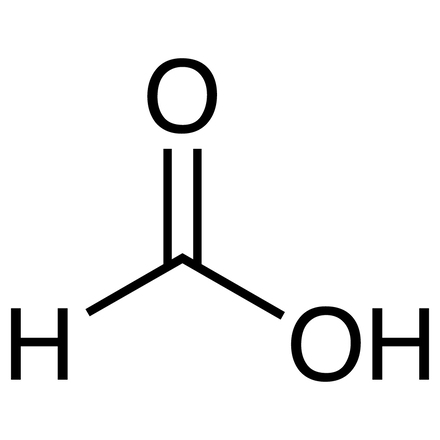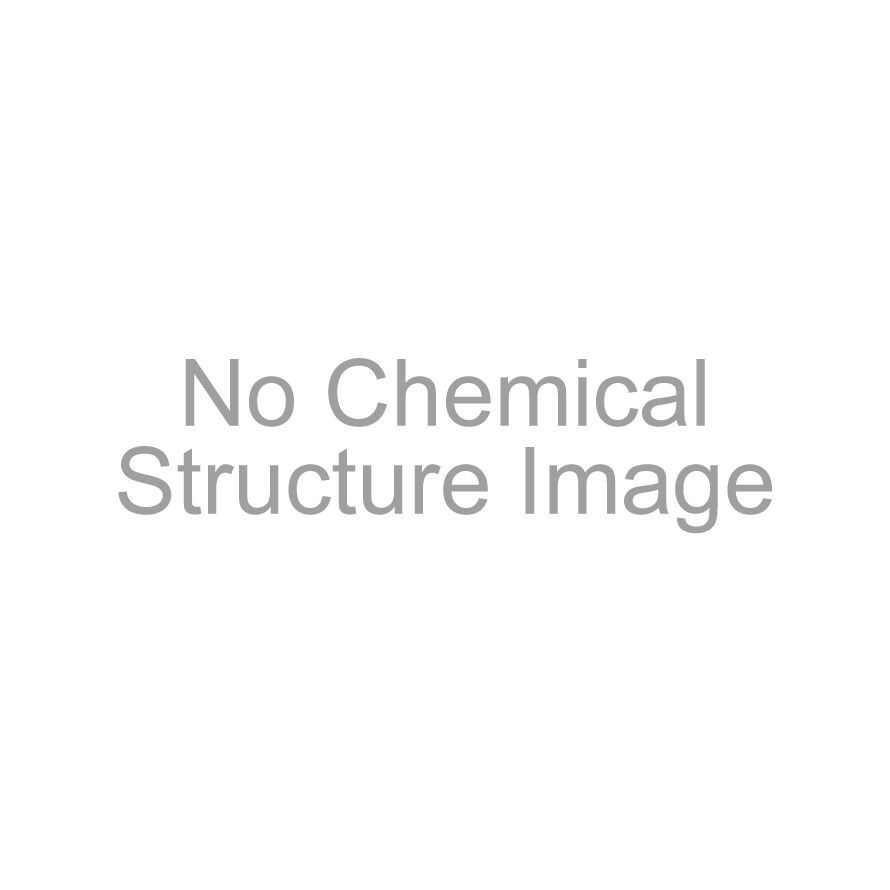Maximum quantity allowed is 999
Please select the quantity
CAS RN: 64-18-6 | Product Number: F0513
Formic Acid

Purity:
Synonyms:
Product Documents:
* Please contact our distributors or
TCI
to order our products. The above prices do not include freight cost, customs, and other charges to the destination.
* The storage conditions are subject to change without notice.
| Product Number | F0513 |
| Molecular Formula / Molecular Weight | CH__2O__2 = 46.03 |
| Physical State (20 deg.C) | Liquid |
Storage Temperature 
|
Room Temperature (Recommended in a cool and dark place, <15°C) |
| Store Under Inert Gas | Store under inert gas |
| Condition to Avoid | Hygroscopic |
| CAS RN | 64-18-6 |
| Reaxys Registry Number | 1209246 |
| Merck Index (14) | 4241 |
| MDL Number | MFCD00003297 |
Specifications
| Appearance | Colorless clear liquid |
| Concentration(Neutralization titration) | min. 88.0 w/w% |
Properties (reference)
| Melting Point | 8 °C |
| Boiling Point | 100 °C |
| Flash point | 57 °C |
| Specific Gravity (20/20) | 1.20 |
| Refractive Index | 1.37 |
| Solubility in water | Completely miscible |
| Solubility (miscible with) | Ethanol, Ether, Methanol |
| Solubility (soluble in) | Benzene, Toluene |
GHS
| Pictogram |




|
| Signal Word | Danger |
| Hazard Statements | H331 : Toxic if inhaled. H302 : Harmful if swallowed. H314 : Causes severe skin burns and eye damage. H370 : Causes damage to organs. H373 : May cause damage to organs through prolonged or repeated exposure. H402 : Harmful to aquatic life. H226 : Flammable liquid and vapor. H290 : May be corrosive to metals. |
| Precautionary Statements | P501 : Dispose of contents/ container to an approved waste disposal plant. P273 : Avoid release to the environment. P260 : Do not breathe dust/ fume/ gas/ mist/ vapors/ spray. P270 : Do not eat, drink or smoke when using this product. P240 : Ground/bond container and receiving equipment. P210 : Keep away from heat/sparks/open flames/hot surfaces. No smoking. P233 : Keep container tightly closed. P234 : Keep only in original container. P243 : Take precautionary measures against static discharge. P241 : Use explosion-proof electrical/ ventilating/ lighting/ equipment. P242 : Use only non-sparking tools. P271 : Use only outdoors or in a well-ventilated area. P264 : Wash skin thoroughly after handling. P280 : Wear protective gloves/ protective clothing/ eye protection/ face protection. P370 + P378 : In case of fire: Use dry sand, dry chemical or alcohol-resistant foam to extinguish. P390 : Absorb spillage to prevent material damage. P308 + P311 : IF exposed or concerned: Call a POISON CENTER/doctor. P303 + P361 + P353 : IF ON SKIN (or hair): Take off immediately all contaminated clothing. Rinse skin with water/shower. P301 + P330 + P331 : IF SWALLOWED: Rinse mouth. Do NOT induce vomiting. P363 : Wash contaminated clothing before reuse. P301 + P312 + P330 : IF SWALLOWED: Call a POISON CENTER/doctor if you feel unwell. Rinse mouth. P304 + P340 + P310 : IF INHALED: Remove person to fresh air and keep comfortable for breathing. Immediately call a POISON CENTER/doctor. P305 + P351 + P338 + P310 : IF IN EYES: Rinse cautiously with water for several minutes. Remove contact lenses, if present and easy to do. Continue rinsing. Immediately call a POISON CENTER/doctor. P403 + P233 : Store in a well-ventilated place. Keep container tightly closed. P403 + P235 : Store in a well-ventilated place. Keep cool. P406 : Store in corrosive resistant container with a resistant inner liner. P405 : Store locked up. |
Related Laws:
| RTECS# | LQ4900000 |
Transport Information:
| UN Number | UN1779 |
| Class | 8 / 3 |
| Packing Group | II |
| H.S.code* | 2915.11-000 |
Application
Deprotection of Tr Groups using Formic Acid

Reference
- Protection for the Hydroxyl Group, Including 1,2- and 1,3-Diols
- P. G. M. Wuts, in Greene’s Protective Groups in Organic Synthesis, 5th ed., ed. by P. G. M. Wuts, John Wiley & Sons, Inc., Hoboken, New Jersey, 2014, Chap. 2, 17.
Application
Synthesis of Formamide Derivatives Catalyzed by Vitamin B1 Hydrochloride

N-Formination of aniline using VB1 as a catalyst:
A mixture of aniline (5 mmol), formic acid (1 mL), and VB1 (0.1 mmol, 2 mol%) is heated at 80 °C under stirring for 10 minutes. After completion of the reaction as indicated by TLC, 20 mL of EtOAc is added and washed with 5% HCl aq., 5% Na2CO3 aq., and brine. Then, the organic layer is dried over MgSO4 and concentrated to afford N-formylaniline in 96% yield without further purification.
A mixture of aniline (5 mmol), formic acid (1 mL), and VB1 (0.1 mmol, 2 mol%) is heated at 80 °C under stirring for 10 minutes. After completion of the reaction as indicated by TLC, 20 mL of EtOAc is added and washed with 5% HCl aq., 5% Na2CO3 aq., and brine. Then, the organic layer is dried over MgSO4 and concentrated to afford N-formylaniline in 96% yield without further purification.
References
- A convenient one-pot synthesis of formamide derivatives using thiamine hydrochloride as a novel catalyst
PubMed Literature
Product Articles
[TCIMAIL No.160] Organic Syntheses Utilizing the Chemical Properties of Chlorosulfonyl Isocyanate[Product Highlights] Synthesis of Formamide Derivatives Catalyzed by Vitamin B1 Hydrochloride
Product Documents (Note: Some products will not have analytical charts available.)
Safety Data Sheet (SDS)
Please select Language.
The requested SDS is not available.
Please Contact Us for more information.
Specifications
C of A & Other Certificates
Please enter Lot Number
Incorrect Lot Number. Please input only the 4-5 alphanumeric characters before the hyphen.
Sample C of A
This is a sample C of A and may not represent a recently manufactured lot of the product.
A sample C of A for this product is not available at this time.
Analytical Charts

Please enter Lot Number
Incorrect Lot Number. Please input only the 4-5 alphanumeric characters before the hyphen.
The requested analytical chart is not available. Sorry for the inconvenience.





![Formic Acid [for LC-MS] Formic Acid [for LC-MS]](/medias/F0654.jpg?context=bWFzdGVyfHJvb3R8MzAyMDF8aW1hZ2UvanBlZ3xhRFJqTDJnd09TODRPVE13TmpZeE16WTNPRE00TDBZd05qVTBMbXB3Wnd8YTEyOThhZGM1YzNmZTE3MTExYmM0NDM0ZjI5MmE1NDEwODNkZTI5Yzc4YTM1MTFiNDIxNmZlZDNhZWViZDdlYg)